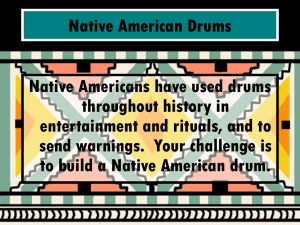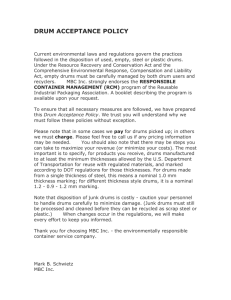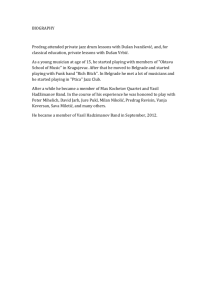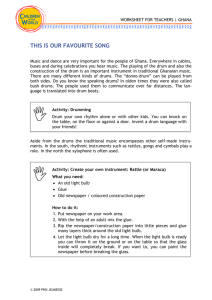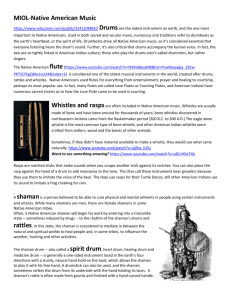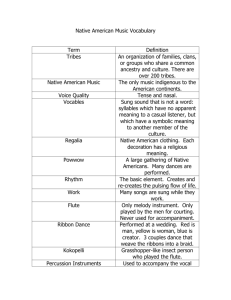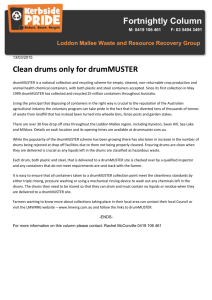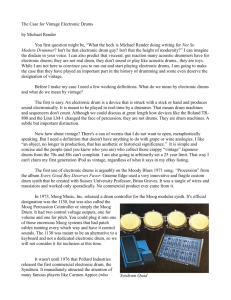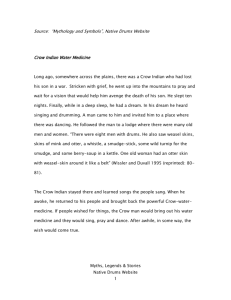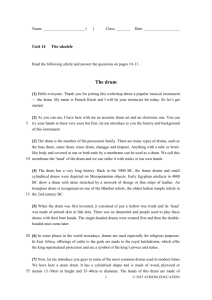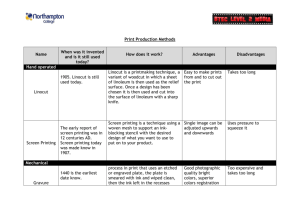to this lesson.
advertisement
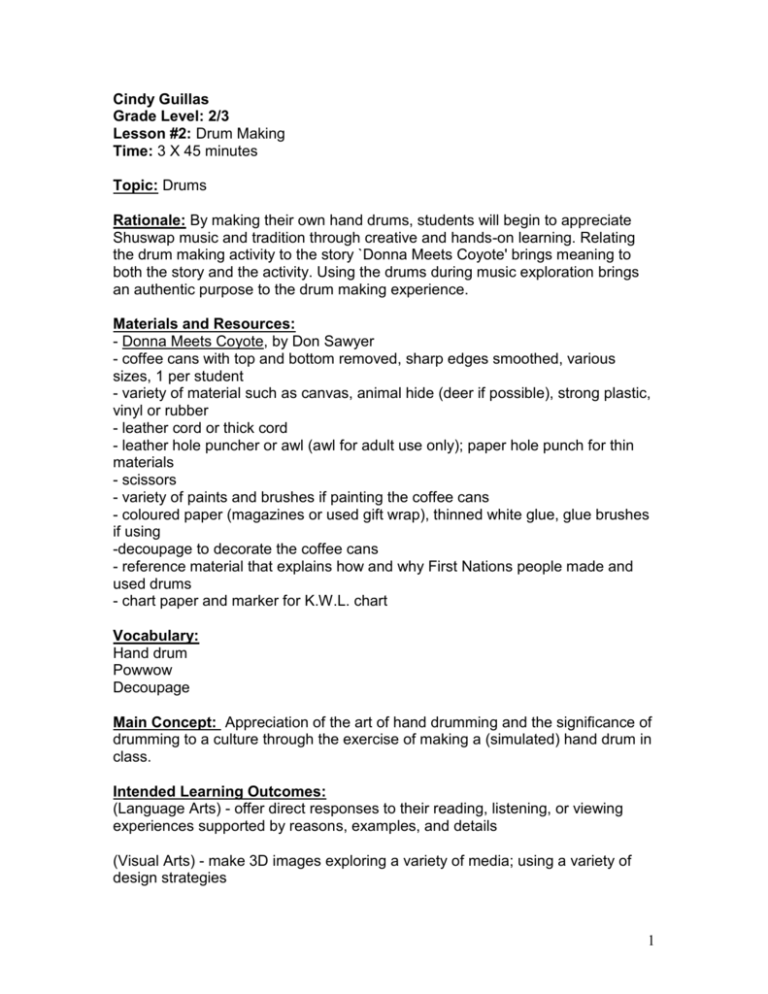
Cindy Guillas Grade Level: 2/3 Lesson #2: Drum Making Time: 3 X 45 minutes Topic: Drums Rationale: By making their own hand drums, students will begin to appreciate Shuswap music and tradition through creative and hands-on learning. Relating the drum making activity to the story `Donna Meets Coyote' brings meaning to both the story and the activity. Using the drums during music exploration brings an authentic purpose to the drum making experience. Materials and Resources: - Donna Meets Coyote, by Don Sawyer - coffee cans with top and bottom removed, sharp edges smoothed, various sizes, 1 per student - variety of material such as canvas, animal hide (deer if possible), strong plastic, vinyl or rubber - leather cord or thick cord - leather hole puncher or awl (awl for adult use only); paper hole punch for thin materials - scissors - variety of paints and brushes if painting the coffee cans - coloured paper (magazines or used gift wrap), thinned white glue, glue brushes if using -decoupage to decorate the coffee cans - reference material that explains how and why First Nations people made and used drums - chart paper and marker for K.W.L. chart Vocabulary: Hand drum Powwow Decoupage Main Concept: Appreciation of the art of hand drumming and the significance of drumming to a culture through the exercise of making a (simulated) hand drum in class. Intended Learning Outcomes: (Language Arts) - offer direct responses to their reading, listening, or viewing experiences supported by reasons, examples, and details (Visual Arts) - make 3D images exploring a variety of media; using a variety of design strategies 1 - create images in response to images from a variety of cultural contexts - use appropriate vocabulary to identify the materials, tools, equipment and processes used to create particular images Planned Learning Activities: PART 1: Introduction to the Powwow and Aboriginal Drumming 1. K.W.L.: Powwow 2. read Chapter 5 of Donna Meets Coyote, where Donna goes to a Powwow. Discuss. 3. Read excerpts from an information book or website material on Powwows, drums, and traditional music. Pass around traditional style drums for children to see, or better yet, invite a traditional Aboriginal drummer in to discuss his/her passion. 4. (Begin each drum making session by reading/discussing the topic from a nonfiction source. Revisit the K.W.L. chart after each reading, ask children to describe any new information gained from the resource and add this to the chart). PART 2: Drum Making Lesson, Day 1 1. Explain that we will be making our own drums (show prepared sample). Talk about traditional materials and compare these to materials we will be using. (Traditionally, wood was used for the drum frame, and animal hide was stretched over the wood frame). (Play Aboriginal music while children work on the drums). 2. Demonstrate the steps required for making a hand drum. It may be helpful to post a chart listing the steps, with diagrams, if possible. Guide the students as they work, reviewing the steps as necessary. a. measure 2 circles of material (canvas, vinyl, rubber or animal hide, if available), 1.5cm in diameter larger than the diameter of the can. b. If using thin material (vinyl), reinforce edges with clear tape. Punch holes about 2 cm apart around the outside edge of circle, about 1cm in from the edge. c. paint coffee can with acrylic paint or cover with decorative torn paper in a decoupage technique using thinned white glue to attach paper to can. Allow to dry overnight. 2 PART 3: Drum Making Lesson, Day 2 1. Begin by reading a nonfiction resource (book or website material) about powwows, drums or Aboriginal music, or consult a FN Resource Worker for material and information. 2. Revisit K.W.L. chart and add any new information learned through the resource. (Play Aboriginal music while children work on the drums). Review the steps required for completion of the drums. a.Using the dry decorated coffee cans, place the two circles of material, one on the bottom of the can, one on the top of the can. b.Sew the material together from top to bottom in a zigzag form around the can. c.Tie with knot. d.Decorate the drum face with traditional Shuswap designs if desired (Provide a variety of images showing possible design elements, for example, coyote, trees, eagle). e.Allow time following the completion of the drums for students to share their creations with classmates. 3. Following this, children will make a journal entry in order to reflect on their drum making experience, using the guiding questions, included. Assessment: Art: Note the extent to which students: - include detail and embellishment on the drum side and face - base their work on traditional Shuswap designs - use new vocabulary appropriately in their journal entry Language Arts: Note the extent to which students: - accurately describe the art process and support this with examples and details -are able to reflect on the experience Extensions: - Invite First Nations drummers into the class to perform, or attend a drumming presentation or workshop. If this is not possible, listen to taped Aboriginal drum music. Students can practice keeping the beat with the music. Following the demonstration by guest drummers, or listening to Aboriginal music, students can write in their journals about the experience. - make drumsticks out of wood with cloth ball on one end. - make rattles similar to those used at Powwows. 3 Integrated Opportunities: Science: test sound of drums made using different materials for the drum face, discuss differences Social Studies: watch video of Shuswap dances, drumming and Powwow, discuss. Physical Education: Use drums to keep beat while performing own dances developed in small groups. Music: the drums can be used regularly when exploring beat in music. Resources Used and Supplementary Materials Available: Sawyer, Don (1988). Donna Meets Coyote, Kamloops, British Columbia: Secwepemc Cultural Education Society. Kalman, Bobbi (1997). Celebrating the Powwow, Ontario, Canada: Crabtree Publishing Company. First Nations Music in Canada, http://www.aincinac.gc.ca/ks/english/pdf/music.pdf My Summer on the Powwow Trail, http://www.aincinac.gc.ca/ks/english/pdf/pow_en.pdf Dancing and Singing, http://www/sd69.bc.ca/~firstn/Secwepemc/sec_village/sec_gatherfs.html Music CD: Various artists (1997). Hearts of the Nations, Aboriginal Women's Voices...in the Studio, Saskatoon, Saskatchewan: Sweet Grass Records. 4 Journal Entry Questions: - Describe two things you learned about making drums. - How are drums used during a powwow? - Describe the process of making hand drums. 5 Cindy Guillas Lesson #2 Drum Making Summative Criteria: Criteria Ratings Comments Useful, accurate, and relevant information 4 3 2 1 is included in the journal entry ________________________________________________________________ Student demonstrates an understanding of the important ideas about the topic 4 3 2 1 (through interaction and activities) ________________________________________________________________ Student demonstrates an appreciation and respect of the Shuswap 4 3 2 1 culture ________________________________________________________________ Student used his/her knowledge of colour, texture, and culture 4 3 2 1 to create an interesting final product Key: 4-Powerful 3-Good 2-Basic 1-Beginning 6
